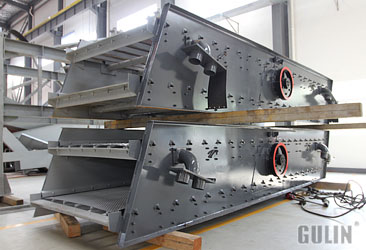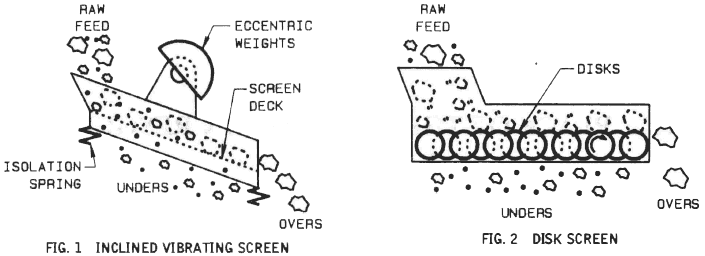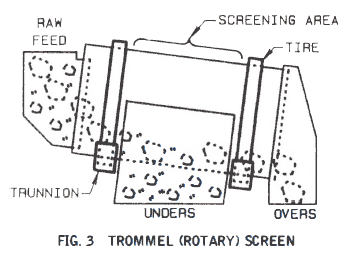Gulin is a professional vibrating screen manufacturer in China, and we offers a ior screening solution for sands, scrap materials, compost, incinerator ash and others.
Application of our vibrating screen machine:
- Manufactured sands, chips and aglime.
- High-moisture materials combined with silt, mud, and clay.
- Incinerator ash, trash, waste coal, clay, sand, and slag.
- Compost, leafy materials, wood waste, and peat moss.
- Auto shredder fluff, shredded tires, and roofing shingles
Vibrating screen design and knowledge
The purpose of any screening operation is separating an incoming product stream into two or more fractions based on size. In solid waste processing, three types of screening machines are most commonly encountered:
the trommel, the disk screen, and the vibrating screen. The vibrating screen, illustrated schematically in Fig. 1, consists primarily of a screen panel mounted in a box. Screens are either punched plate or mesh. A drive imparts either a vibratory or gyratory motion to the box. The feed material is agitated, allowing fine material to pass through the screen.
The disk screen, outlined in Fig. 2, consists of a series of shaft-mounted disks. The screen opening is defined by the distance between the disks in one direction, and the distance between the shafts in the other. The shafts rotate, transporting the feed along the length of the machine and presenting the material to the screen openings.
The trommel is a sloped, rotating, screen-covered drum as shown in Fig. 3. As with a vibrating screen, the screen surface may be either a mesh or punched plate; punched plate is used much more commonly. The feed advances through the drum by virtue of both the slope and the rotation. The rotation continually turns the material, ensuring that all of the feed is presented to the screen apertures.
Each machine described above has both advantages and weaknesses based on the nature of the feed and the separation desired. Vibrating screens work best with relatively dry, granular mixtures such as grit, separating well and offering a substantial advantage over the trommel in terms of cost and space requirements. The vibrating screen under any circumstance performs poorly when the amount of undersize is a small fraction of the feed stream. Mixtures of this sort (i.e., dry and granular with a high percentage of undersize) are rarely found in waste processing systems, however, so good applications for the vibrating screen are quite few in this field.
Most waste streams consist of damp, heterogeneous mixtures with broad size distributions. They typically contain a high percentage of large, flat oversize items like paper, plywood, or plastic sheeting. Furthermore, a good percentage of the waste may be packed in plastic bags. In order to effectively separate such streams, the feed must be tumbled to prevent these large oversize items from shielding the undersize from the screen. This shielding occurs when undersize material rides across the screen on top of the oversize, never being exposed to a screen aperture. For primary screening (i.e., screening prior to any other operation such as shredding), the screen should be able to break open the plastic bags in order to liberate the material for screening.
The disk screen’s inability to tum material over strongly limits its usefulness in solid waste processing. It is prone to the undersize carry-over described above; further, it doesn’t break open plastic bags. It shines brightest in applications requiring removal as oversize of long pieces that could conceivably pass on-end through a screen opening. In fact, one of the original purposes of the disk screen was to remove long wooden shives from streams of wood chips. The tumbling action of the trommel can up-end long pieces and pass them to the undersize; the disk screen has little tendency to do that. Disk screens may sometimes be used when scalping, i.e., when the oversize constitutes no more than 10% to 20% of the incoming feed, and large, flat oversize is absent. Disk screens may offer some advantage over trommels in terms of cost and space requirements.
The nature of waste streams generally favors the use of trommels. The primary advantage of the trommel is that, unlike either the disk or vibrating screen, it does thoroughly mix and tumble the feed stream. Further advantages of the trommel include its mechanical simplicity, and its ability to break open many, or, if properly equipped, almost all, of the plastic bags in the feed.




